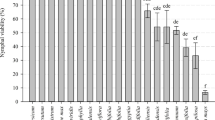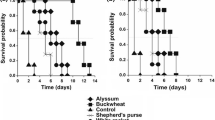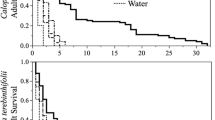Abstract
Bemisia tabaci (Genn.) biotype B (Hemiptera: Aleyrodidae) is regarded as a pest with a large number of hosts, including crops and weeds. The performance of this whitefly on seven weeds was evaluated in order to identify the most suitable host. The following weeds that are very common in intense agricultural areas in the state of São Paulo, Brazil, were selected for this study: spurge (Euphorbia heterophylla), beggarticks (Bidens pilosa), red tasselflower (Emilia sonchifolia), small-flower galinsoga (Galinsoga parviflora), pigweed (Amaranthus viridis), black nightshade (Solanum americanum), and morning glory (Ipomoea sp.). In free-choice tests, adult preference and oviposition were greatest on spurge. In contrast, morning glory was the least attractive and least oviposited plant. In assays carried out for egg–adult development, egg viability was greater than 87% over all weeds, whereas nymph viability ranged from 74 to 97%. The developmental period from egg to adult ranged from 26.7 to 49.1 days among the hosts under study. The lowest nymph density rate was observed for beggarticks and morning glory. Cluster analysis resulted in a single group formed by spurge, indicating its superiority as a host for B. tabaci biotype B. Even though the parameters evaluated indicate that spurge is the most suitable host among the weeds, all the others allow the reproduction of B. tabaci biotype B. For this reason, they should be observed during cropping and the intercrop period in areas infested by this whitefly.


Similar content being viewed by others
References
Albergaria NMMS, Cividanes FJ (2002) Exigências térmicas de Bemisia tabaci (Genn.) biótipo B (Hemiptera: Aleyrodidae). Neotrop Entomol 31:359–363
Alves AC, Lourenção AL, Melo AMT (2005) Resistência de genótipos de aboboreira a Bemisia tabaci (Genn.) biótipo B (Hemiptera: Aleyrodidae). Neotrop Entomol 34:973–979
Arnaud LSEP, Santos CDG, Lima JAA, Feitosa FAA (2007) Predominância de begomovírus em tomateiros na região produtora da Ibiapaba, Ceará, e sua detecção natural em plantas daninhas. Fitopatol Bras 32:241–246
Berry SD, Fondong VN, Rey C, Rogan D, Fauquet CM, Brown JK (2004) Molecular evidence for five distinct Bemisia tabaci (Homoptera: Aleyrodidae) geographic haplotypes associated with cassava plants in sub-Saharan Africa. Ann Entomol Soc Am 97:852–859
Brown JK (2010) Phylogenetic biology of the Bemisia tabaci sibling species group. In: Stansly PA, Naranjo SE (eds) Bemisia: bionomics and management of a global pest. Springer, Dordrecht, pp 31–67
Brown JK, Frohlich DR, Rosell RC (1995) The sweetpotato or silverleaf whiteflies: biotypes of Bemisia tabaci or a species complex? Ann Rev Entomol 40:511–534
Butler-Junior GD, Henneberry TJ, Clayton TE (1983) Bemisia tabaci (Homoptera: Aleyrodidae): development, oviposition and longevity in relation to temperature. Ann Entomol Soc Am 76:310–313
Calvitti M, Remotti PC (1998) Host preference and performance of Bemisia argentifolii (Homoptera: Aleyrodidae) on weeds in Central Italy. Environ Entomol 27:1350–1356
Campos ZR, Boiça-Junior AL, Lourenção AL, Campos AR (2009) Parâmetros biológicos de Bemisia tabaci (Genn.) biótipo B (Hemiptera: Aleyrodidae) em genótipos de algodoeiro. Bragantia 68:1003–1007
Coelho SAMP, Lourenção AL, Melo AMT, Schammass EA (2009) Resistência de meloeiro a Bemisia tabaci biótipo B. Bragantia 68:1025–1035
De Barro PJ, Liu S, Boykin LM, Dinsdale AB (2011) Bemisia tabaci: a statement of species status. Ann Rev Entomol 56:1–19
Gachoka KK, Obeng-Ofori D, Danquah EY (2005) Host suitability of two Ghanaian biotypes of Bemisia tabaci (Homoptera: Aleyrodidae) on five common tropical weeds. Int J Trop Insect Sci 25:236–244
Hilje L, Morales FJ (2008) Whitefly bioecology and management in Latin America. In: Capinera J (ed) Encyclopedia of entomology. Springer, Heidelberg, pp 4250–4260
Hilje L, Costa HS, Stansly PA (2001) Cultural practices for managing Bemisia tabaci and associated viral diseases. Crop Prot 20:801–812
Inbar M, Gerling D (2008) Plant-mediated interactions between whiteflies, herbivores, and natural enemies. Annu Rev Entomol 53:431–438
Kiill LHP, Haji FNP, Lima PCF (1998) Avaliação do grau de infestação de mosca branca (Bemisia spp.) em plantas invasoras em áreas de frutíferas irrigadas. In: Encontro Latino-Americano e do Caribe sobre Mosca-branca e Geminivirus (Recife, BR).
Lourenção AL, Nagai H (1994) Surtos populacionais de Bemisia tabaci no Estado de São Paulo. Bragantia 53:53–59
McAuslane HJ (1996) Influence of leaf pubescence on ovipositional preference of Bemisia argentifolii (Homoptera: Aleyrodidae) on soybean. Environ Entomol 25:834–841
Mizuno ACR, Villas Bôas GL (1997) Biologia da mosca-branca (Bemisia argentifolii) em tomate e repolho. Available at: http://www.cnph.embrapa.br/pa/pa01.html. Accessed 15 Mar 2010
Morales FJ (2011) Interaction between Bemisia tabaci, begomoviruses, and plant species in Latin America and the Caribbean. In: Thompson WMO (ed) The whitefly, Bemisia tabaci (Homoptera: Aleyrodidae) interaction with geminivirus-infected host plants. Springer, London, pp 15–49
Mound LA, Halsey SH (1978) Whitefly of the world: a systematic catalogue of the Aleyrodidae (Homoptera) with host plant and natural enemy data. British Museum (Natural History). Wiley, Chichester, 340 p
Nava-Camberos U, Riley DG, Harris MK (2001) Temperature and host plant effects on development, survival, and fecundity of Bemisia argentifolli (Homoptera: Aleyrodidae). Environ Entomol 30:55–63
Oriani MAG, Vendramim JD, Brunherotto R (2008) Aspectos biológicos de Bemisia tabaci biótipo B (Hemiptera: Aleyrodidae) em seis genótipos de feijoeiro. Neotrop Entomol 37:191–195
Oriani MAG, Vendramim JD, Vasconcelos CJ (2011) No-choice ovipositional nonpreference of Bemisia tabaci (Gennadius) B biotype on tomato genotypes. Sci Agric 68:147–153
Perring TM (2001) The Bemisia tabaci species complex. Crop Prot 20:725–737
SAS Institute (2002) SAS/STAT User’s guide, version 9.0, TS level 00MO. SAS Institute Inc, Cary
Silva MS, Lourenção AL, Souza-Dias JAC, Miranda-Filho HS, Ramos VJ, Schammass EA (2008) Resistance of potato genotypes (Solanum spp.) to Bemisia tabaci biotype B. Hortic Bras 26:221–226
Smith CM (1989) Plant resistance to insects—a fundamental approach. Wiley, New York, pp 53–74
Smith CM, Khan ZR, Pathak MD (1994) Techniques for evaluating insect resistance in crop plants. Lewis, Boca Raton, pp 17–114
Torres LC, Souza B, Amaral BB, Tanque RL (2007) Biologia e não-preferência para oviposição por Bemisia tabaci (Gennadius) biótipo B (Hemiptera: Aleyrodidae) em cultivares de algodoeiro. Neotrop Entomol 36:445–453
Valle GE, Lourenção AL, Pinheiro JB (2012a) Adult attractiveness and oviposition preference of Bemisia tabaci biotype B in soybean genotypes with different trichome density. J Pest Sci 85:431–442
Valle GE, Lourenção AL, Zucchi MI, Pinheiro JB, Abreu AG (2012b) MtDNA variability in whitefly (Bemisia tabaci) populations in Brazil. Genet Mol Res 10:2155–2164
Villas Bôas GL, Inoue-Nagata AK, Lima RS, Pereira W, Giordano LB (2003) Avaliação de plantas daninhas como possíveis hospedeiras de mosca-branca. Hortic Bras 21:344–347
Walker GP, Perring TM, Freeman TP (2010) Life history, functional anatomy, feeding and mating behavior. In: Stansly PA, Naranjo SE (eds) Bemisia: bionomics and management of a global pest. Springer, New York, pp 109–160
Acknowledgments
The authors would like to thank Dr. Jorge Braz Torres for the helpful comments to improve this manuscript, Dr. Robert Deuber for his comments on the weeds, the CAPES Foundation for the financial support, and the Conselho Nacional de Desenvolvimento Científico e Tecnológico (CNPq) for the research productivity fellowship to the second author.
Author information
Authors and Affiliations
Corresponding author
Additional information
Edited by Jorge B Torres – UFRPE
Rights and permissions
About this article
Cite this article
Sottoriva, L.D.M., Lourenção, A.L. & Colombo, C.A. Performance of Bemisia tabaci (Genn.) Biotype B (Hemiptera: Aleyrodidae) on Weeds. Neotrop Entomol 43, 574–581 (2014). https://doi.org/10.1007/s13744-014-0238-5
Received:
Accepted:
Published:
Issue Date:
DOI: https://doi.org/10.1007/s13744-014-0238-5




